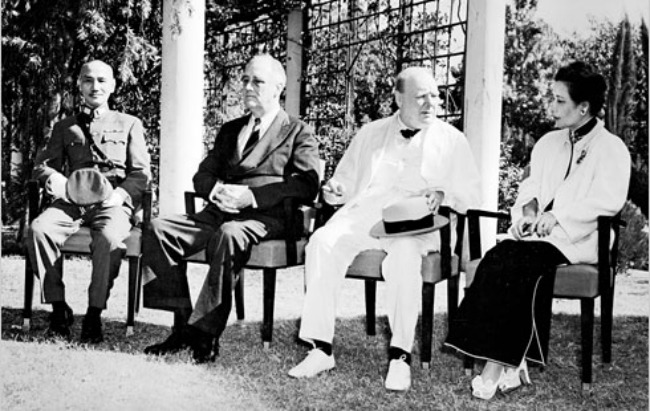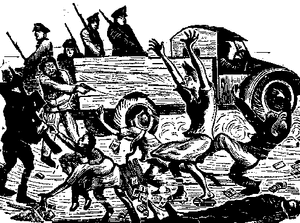Chiang Kai-shek, Lin Chia-lung, and KMT Bonapartism in Taiwan
by Parson Young
語言:
English /// 中文
Photo Credit: Pre-1949 Photo of Chiang Kai-Shek
THE RECENT MEETING between KMT chairman Eric Chu and Chinese leader Xi Jinping, in his capacity as the chairman of the Chinese “Communist” Party, once again ignited thunderous denunciation from the Taiwanese Left. One of the many criticisms against Chu’s defeated posture in the face of Xi was as long-standing question of whether KMT deserves to even exist as a political party in Taiwan. We can write mountains of books condemning the KMT and calling for its destruction, as we’ve done for decades. Yet, it remains not only a major political party, but also a democratically elected ruling party of our country of 8 years. There isn’t another authoritarian political party in the world that survives and adapts to liberal democracy as well as the KMT. We already know that the reason for their resilience certainly isn’t the righteousness of their ideology or moral integrity. It is then worthwhile to find a material, historical analysis on how KMT was able to adapt, morph, and remains in control of the Taiwanese society.
In my quest to answer this question, I came across an excellent Ph. D dissertation authored by the incumbent mayor of Taichung, Lin Chia-lung, written when he was completing his doctorate in Political Science at Yale University. The dissertation, entitled Paths to Democracy: Taiwan in Comparative Perspective, recounts the history of KMT’s party restructuring process after it migrated to Taiwan as a reaction to its defeat by Mao. With superb scholarship, Lin was able to provide a detailed insight into how the KMT and Taiwanese elites interacted with each other in order for the former to be able to survive as an immigrant regime. Lin’s findings revealed a quintessential lesson in the Marxist concept of Bonapartism, as well as an illustration of how the KMT took advantage of economic classes of Taiwan to successfully morph and grow into the present.
Of course, this article’s heavy referencing of Lin’s dissertation is in no way an endorsement of his bourgeois party the DPP, who is not so different from the KMT of our time in essence. This article appreciates the accuracy and scholastic heft of Lin’s academic work, and analyzes the facts it illustrates from a Marxist perspective.
Chiang Kai-shek and the KMT as a Bonapartist Regime in Taiwan
ON THE EVE of its defeat by Mao, the KMT in China was doubtlessly a corporatist party serving the rich, starting from Chiang Kai-shek’s wife Soong Mei-ling’s tycoon family. The KMT’s blatant corruption, disorganization, and factional in-fighting amongst competing interest groups, were just few of the many glaring reasons why Mao was able to overthrow them with significantly less resources.
 Chiang Kai-Shek, Franklin D. Roosevelt, Winston Churchill, and Soong Mei-Ling in 1942. Photo credit: WikiMedia Commons
Chiang Kai-Shek, Franklin D. Roosevelt, Winston Churchill, and Soong Mei-Ling in 1942. Photo credit: WikiMedia Commons
After installing himself in Taiwan, Chiang Kai-shek was aware of the party’s shortcomings, as well as its lack of support among the Taiwanese population following the 228 Massacre, which quickly led the population to become thoroughly disillusioned with the view of the KMT government as their saviors from Japanese colonialists. To quickly ground himself in Taiwan and prepare for a counter-attack against Mao, Chiang ordered a series of restructuring of the KMT and the governance of Taiwan in an effort to penetrate, monitor, and control the Taiwanese society before Mao did.
Within the party, the KMT was restructured into a pseudo-Leninist “revolutionary party,” with a central party apparatus in the firm control of Chiang and his cronies, while the party also branched out into party cells at the neighborhood level in order to recruit and train native Taiwanese KMT cadre. The “revolutionary task” of the part at the time was actually a counterrevolutionary task: retaking the mainland. Unlike a real Leninist party founded upon the principle of democratic centralism, where the membership is trained and all party policy is up for discussion and debate, Chiang modeled his party on a top-down military structure and used it as a monitor and control mechanism. Lin demonstrates that this party structure was particularly effective in penetrating urban populations, especially in schools and professional circles. [1] It was, however, poor in extending the party’s influence in rural areas and among workers.
To more tightly control the workers, the KMT facetiously allowed the formation of labor unions under tight supervision. With an unwritten rule of general secretary having to be a mainlander, the board of director having to be a native Taiwanese, and both KMT party members, unions were strictly enforced. The KMT government also offered a large array of insurance and benefits to workers, which was not particularly costly, as industrial workers only accounted for 2.4% of the total population in Taiwan in 1952. [2] These government-monitored unions could not carry out real union functions such as striking, and in effect became a tool for the KMT to recruit more members and vote mobilization during local elections. [3] Three years after these “unions” were legalized, over 23% of the union members joined the KMT. [4]
With respect to rural elites and farmers, the KMT followed Japan’s example and embarked on a series of rent reduction policies and “lands-to-the-tiller” programs to win over the peasantry while buying off the landlords. [5] Nevertheless, the majority of the peasantry was still strongly influenced by their local elites, who dominated farmer associations since Japanese Colonialism and hold tremendous influence over local affairs. In order to absorb these local clientelist networks into its fold, the KMT began to hold extremely limited local elections.
According to Lin’s findings, the local elections were the most important mechanisms for the KMT to assimilate the local bourgeoisie to help it control the rural Taiwan. Local elites already hold significant amount of mobilizing power in their territories, and therefore could easily command votes from the peasants they control. The KMT allowed these elites to win the local elects to provide them prestige and legitimacy, and later invite them to join the party, a strategy that proved successful according to Lin. [6] It is also worth noting that, as a legacy of the 228 Massacre, most anti-KMT Taiwanese elites were purged. Anti-KMT Taiwanese elites were largely petty bourgeois such as physicians, lawyers, professionals. As a result, those local elites who the KMT was able to recruit were predominantly bourgeoisie, such as businessman and landlords. [7]
The result of this series of KMT restructuring efforts was that it gradually gained control over the Taiwanese population through penetrating the urban populace and coming to control the rural areas through co-opting local elites. At the same time the KMT created an appearance of legitimacy by fashioning itself as a revolutionary party bent on retaking China through the ideological strength of Sun Yat-sen’s Three Principles of the People, and touting its increasing number of rank-and-file cadre who were native Taiwanese.
 Woodcut engraving depicting the 228 Massacre. Photo credit: 228 Museum
Woodcut engraving depicting the 228 Massacre. Photo credit: 228 Museum
Of course, such trickeries could not blind the Taiwanese people from the brutal everyday oppression of the KMT. However, we have to concede that these moves at least secured the KMT’s place in Taiwanese politics in the short and long term, and later allowed it to survive through the transition into bourgeois democracy by becoming a quintessential bourgeois party. Chiang Kai-shek’s stratagems were far from historically unprecedented, however. Karl Marx had already analyzed this phenomenon in 1852, in the context of post-Napoleonic France, when he observed the use of Bonapartism as a reactionary strategy to keep the ruling class in control.
Bonapartism: From Marx to Trotsky to Taiwan
MARX COINED the term Bonapartism after Louis Bonaparte, the nephew of Napoleon Bonaparte, who managed to get himself elected as President of France on the basis of association with his more famous uncle, despite his lack of political experience. Bonaparte later dismissed the legislature, and proclaimed himself Emperor.
Bonapartism describes a situation where reactionary figures could hijack a revolutionary situation by styling themselves as champions of the underclasses of society, but in reality implementing policies that ultimately benefit the ruling class. In The Eighteenth Brumaire of Louis Bonaparte, Marx detailed every step Louis Bonaparte took to rally support from the elites, petty bourgeois, as well as the peasantry to get himself legitimately elected as President, and then proceeded to reverse democracy back into monarchy. Many of Bonaparte’s strategy included appeals to conservative morals and ideologies, as well as promising more benefits for underclass supporters should he get elected. In this sense, where Bonapartism is a phenomenon in which a dictator maintains power through his ability to maintain popular support, Louis Bonaparte is the first modern dictator and a prototype of 20th century fascism.
Leon Trotsky importantly expanded the concept of Bonapartism, offering important observations of the characteristic of Bonapartist tactics in context of the rise of fascism. Trotsky predicted the eventual dictatorship of Hitler and Nazism in Germany a year before its formation in 1932, highlighting the means by which Germany’s increasing class tension gave way for the state to significantly expand its bureaucracy, police, and military power. [8] The state, temporarily raised above class relations, can then have a power to control both the ruling class and the oppressed class in order to preserve its privileged status. This was already underway in the Bruening and Von Papen governments that preceded Hitler’s election as Chancellor. Trotsky theorized Fascism/Nazism’s ability to drum up populist sentiments and simultaneously garner the support would eventually help them to take control of the increasingly domineering German state, and it did happen. Interestingly, Trotsky reminded us of the ultimate function of the state: servicing and maintaining the power of the ruling class. He made a humorous yet accurate remark regarding the Bonapartist state:
“A government does not cease being the clerk of the property-owners. Yet the clerk sits on the back of the boss, rubs his neck raw and does not hesitate at times to dig his boots into his face.” [9]
Chiang’s rule as dictator was Bonapartist in nature and in that way founded upon maintaining a form of popular support within Taiwan. The KMT on one hand appears to punish the local gentry in favor of the people on the one hand, while at the same time managing to co-opt bourgeois elements into its ranks. At the same time, though the KMT had an appearance of a “revolutionary” party, its party structure is actually an ever-expanding bureaucracy that polices every aspect of society while ideologically justifying itself a process of militarization. Where this was successful, the working class was taken in by the series of seemingly friendly gesture from the KMT to relinquish their resistance, while the local ruling class was invited to join the new club of oppressors. [10]
The KMT state machine marshaled enough power to monitor urban life, control the labor unions, win over farmers and local elites and incorporate friendly Taiwanese bourgeois into its fold while crushing the ones who opposed it. For the other half of society that stood against it, the KMT used violence, detention, expulsion, and execution to repress the population, a chapter in history we are all too familiar with. Chiang Kai-shek’s strategy was far from original, believing that would give him too much credit. How his regime behaved was nothing more than a typical expression of a Bonapartist state.
The KMT’s Transformation Into a Bourgeois Party Under American and Chinese Imperialism
IN MARX’S ANALYSIS, Bonapartism was never going to be an everlasting arrangement. The police state and the bureaucracy would degenerate and give into the pressure of capitalism, and enough freedom will be given to the bourgeois class for them to completely rule society once more without the need for a Bonapartist dictator. This, of course, was what happened to the KMT in Taiwan in the long-run as a client state of US Imperialism.
As time passed on and the elderly mainlander faction leaders of KMT withered away, the newly emergent native Taiwanese bourgeois begin to grow in number and influence within the KMT. With the economic liberalization and the boom of the 1980s, native Taiwanese within the KMT came to control the central party apparatus traditionally helmed by Mainland Chinese. This culminated in the 1996 general election when the KMT nominated the Taiwanese-born Lee Teng-hui to be its presidential candidate, and a breakaway KMT faction leader, Lin Yang-kang, also a native Taiwanese, ran as an independent as a result of failing to procure the party’s nomination. Lee, Lin, and their cohort represent an increasingly strong native Taiwanese bourgeois class who are ideologically ambivalent to Sun Yat-Senism but who still economically side with capital. Though they do not in any way represent the interests of the Taiwanese working class, they proved instrumental in transforming the KMT from a Bonapartist party to the general bourgeois party in favor of Chinese capital we see today.
 Lee Teng-Hui speaking at Cornell University in 1995. Photo credit: Cornell University
Lee Teng-Hui speaking at Cornell University in 1995. Photo credit: Cornell University
To be sure, this phenomenon is not to be confused with a bourgeois revolution like the French Revolution, which implies that the bourgeois of Taiwan would be in full control over the country’s politics and economy. By 1996 when Taiwan held its first democratic presidential election via popular vote, factors such as China’s threat of missile bombardment and US’s refusal to endorse Taiwanese independence left the voters, even the bourgeois, few choices. To this day, Taiwan is still barred from joining any international financial organizations as a nation due to the Chinese and American factors. These factors prevent Taiwan from behaving as a fully capitalist country such as accessing international credit and implement austerity as commanded by the IMF. However, the class struggle under capitalism is already fully realized in Taiwan, and thus Taiwan’s economic problems today are the same ones faced by countries all over the world.
This author is obviously not forgetting the countless sacrifices and hard work that past democracy activists have made for Taiwan. Their dedication obviously contributed to the establishment of the liberal democracy that Taiwan has today. However this transformation did not involve the complete elimination of existing ruling class headed the KMT bureaucracy, and instead was done through a series of compromises that allowed the KMT to continue existing with significant political power. The influence of US imperialism also shaped to the political landscape of Taiwan today as well as its economic development into a fully capitalist society. This means that Taiwan unlike what Marx suggested in his time, didn’t go through a Bourgeois revolution in order to develop a capitalist economy and class structure. Demographically speaking Taiwan already has a large working class that holds the majority of productive power. This means that as a society Taiwan doesn’t need another bourgeois revolution, but a working-class socialist proletarian revolution in order to make lasting improvements.
The Lesson From Bonapartism
THE KMT BONAPARTIST chapter of Taiwanese history was one soaked in blood and tears, but one must learn from it to ensure the success of any future revolutionary movements. In an earlier article, I discussed why a socialist revolution is the only hope for an independent Taiwan. For this revolution to succeed, one of the many necessary tasks is to be fully aware of the trickery used by the bourgeoisie to co-opt the working class. Offers of significant compromise and labor benefits may be enticing for the working class, indeed. Nevertheless, we must always remember that the point of the revolution is not to lessen the exploitation of the working class, but to permanently end it by putting the working class in charge of society.
[1] Lin Chia-lung, Path to Democracy: Taiwan in Comparative Perspective, Diss., Yale University, (Ann Arbor: UMI, 1998), 125-136.
[2] Ibid., 123.
[3] Ibid., 122.
[4] Ibid., 122.
[5] Ibid., 105
[6] Ibid., 142.
[7] Ibid., 151.
[8] Leon Trotsky, “Von Papen & Hitler Bonapartism and Fascism,” in The Militant 5.34 (1932), Marxists.org, Web, 7 May 2015, <https://www.marxists.org/archive/trotsky/1932/08/onlyroad1.htm>.
[9] Ibid.
[10] In this article, we’re primarily discussing bourgeois Bonapartism, which was what Marx witnessed during his lifetime, and perfectly describes the KMT’s tactics in Taiwan. Trotsky also made important analysis on Fascism, which is slightly different from bourgeois Bonapartism, and proletarian Bonapartism, which Trotsky used to describe pseudo-Marxist regimes such as Stalin and Mao.




